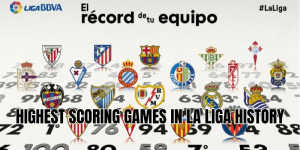In the glittering world of Spanish football, where prestige and performance collide, the La Liga transfer records of all time tell a story of ambition, rivalry, and astronomical sums. In this article, DaoKick invites you on a journey through history —. We’ll dig deep into who smashed the records, how much they paid, and what these deals meant for clubs, fans, and players.
The evolution of transfer records in La Liga

Before the era of hundreds of millions, transfer fees in Spanish football were modest. The transfer record history of La Liga shows how quickly the market inflated in just a few decades.
Early record-breaking signings were often domestic or regional, crossing small financial thresholds — for examplemid-20th century transfer might top a few hundred thousand euros (or their historical equivalent). Over time, as TV rights, global branding, and commercial revenue exploded, clubs with global ambitions began pushing the price ceiling ever higher.
The timeline of “record breakers” helps us see the pattern: each new era, especially the 1990s onward, introduced a new level of spending, culminating in the multi-tens or hundreds of millions era we live in today.
Top 10 most expensive La Liga signings ever

Let’s cut to the chase — who holds the La Liga transfer records of all time? While different lists vary slightly depending on add-ons and currency fluctuations, a consensus emerges around these names.
| Rank | Player | To (La Liga Club) | Reported Fee* |
| 1 | Neymar | Barcelona | ~€222 million |
| 2 | Philippe Coutinho | Barcelona | ~€145 million |
| 3 | Ousmane Dembélé | Barcelona | ~€135 million |
| 4 | João Félix | Atlético Madrid | ~€126 million |
| 5 | Antoine Griezmann | Barcelona | ~€120–€107 million (depending on structure) allboast.com]) |
| 6 | Luis Suárez | Barcelona | ~€81.7 million aLiga Expert]) |
| 7 | Frenkie de Jong | Barcelona | ~€86 million |
| 8 | Eden Hazard | Real Madrid | (some sources around €90–100 million) |
| 9 | Gareth Bale | Real Madrid | ~€100 million+ |
| 10 | Cristiano Ronaldo | Real Madrid | ~€94 million (or similar, depending on scale) |
*Fees may or may not include add-ons or bonuses; rankings can shift based on those adjustments.
Observations from the list
- Barcelona dominates the top spots, with most of their marquee signings pushing the La Liga ceiling higher.
- Even “lower-ranked” record deals like Suárez or De Jong are still staggering in their scale relative to historical norms.
- Real Madrid’s top transfer records (e.g. Bale, Hazard, Ronaldo) reflect that even a club as wealthy as “Los Blancos” must occasionally match or trail Barcelona’s headline-making moves.
- Some transfers such as Mbappé’s rumored move to Real Madrid were free transfers (i.e. no direct fee), meaning they don’t figure in these “most expensive signings” lists.
Why Barcelona features so heavily — financial muscle, ambition, and branding

When we see so many of the top fees coming through Barcelona, it’s no accident.
- Revenue and commercial clout
- Barcelona’s global brand, sponsorships, and marketing have historically allowed it to project financial power that few others can match.
- Sporting ambition
- To compete with Real Madrid, to win the Champions League, and to attract top global talent, Barcelona has often prioritized signature signings that shift perceptions.
- Willingness to gamble
- Some of those big-money deals were high-risk, high-reward bets (think Coutinho, Dembélé). Not all succeeded fully, but they at least made headlines.
- Defensive spending in context
- While Barcelona often grabbed the headlines for the biggest fees, many clubs in La Liga have remained more disciplined, focusing on sustainability rather than headline-making splurges.
Record trends: When and how records were broken
Incremental steps to six- and seven-figure deals
Before the modern era, even a move for several hundred thousand euros was notable. As revenue.
2000s: the “Galáctico” era
Although many marquee names were homegrown or internal moves, this era laid the groundwork for bigger transfers across Europe. Spain’s top clubs already had financial firepower and fan expectations growing.
2010s-2020s: the leap
This is where things get explosive. Neymar’s €222 million move in 2017 is the landmark moment when the scale of transfers leaped into a new domain. Since then, record after record has been challenged or nudged.
The presence of add-ons, performance clauses, and incremental payments has made exact rankings a bit fluid — which is why you’ll see different sources with slightly adjusted figures.
Transfers that almost made it — honors for runners-up and surprises
While the top 10 list casts a long shadow, other moves deserve mention — players who nearly cracked the ceiling or became controversial statements:
- Unconventional deals: Some transfers are “free” moves with massive signing-on bonuses. Those don’t always count in standard rankings.
- Rookies with huge price tags: Young talents arriving for high fees (e.g. De Jong, João Félix) sometimes carry more speculative risk.
- Failed or underwhelming signings: Paying big doesn’t guarantee success — players like Coutinho or Dembélé have been scrutinized more for their struggles in Spain than their transfer price tag.
These near-misses and flops offer cautionary tales: a club’s financial audacity sometimes meets the unforgiving test of performance, adaptation, injuries, or pressure.
Real Madrid’s top transfer records in La Liga context
Even though many of the all-time La Liga transfer records skew toward Barcelona, Real Madrid has its own storied high-ticket moves. Their internal record signings have often aligned with the league’s top deals:
- Gareth Bale: one of Madrid’s iconic megadeals, often cited among La Liga’s expensive transfers.
- Eden Hazard: though he struggled to fulfill expectations, his move was a major financial statement.
- Cristiano Ronaldo: his arrival.
Madrid’s strategy at times has been less about purely breaking transfer records and more about finding the right fit — but when they have invested big, it has made headlines.
What the La Liga transfer records of all time tell us
- The record transfers underscore how Spanish football became a global stage for elite talent, not just regional dominance.
- Big-money signings reflect both sporting ambition and brand positioning: clubs want to signal “We compete at the highest level.”
- There’s inherent risk: not all record-makers succeed. Some become legends, others cautionary tales.
- Structural changes —, to global fanbases — shifted what clubs are willing and able to spend.
These deals serve not just as financial trivia, but as milestones in football history, marking shifts in power, style, and identity across Spanish and European football.
Conclusion
La Liga transfer records of all time offer more than a list of names and numbers — they map the evolution of Spanish football’s ambition, rivalry, and risk. From modest beginnings to record-shattering fees, each deal marks a moment where clubs bet on greatness. For fans wanting to trace how Barcelona, Real Madrid, and others have wielded financial muscle on the pitch, these records are essential reference points.
If you enjoyed this breakdown and want deep dives into specific transfers, or want lists for other leagues (Premier League, Serie A, Bundesliga), just say the word — DaoKick has got you covered.



